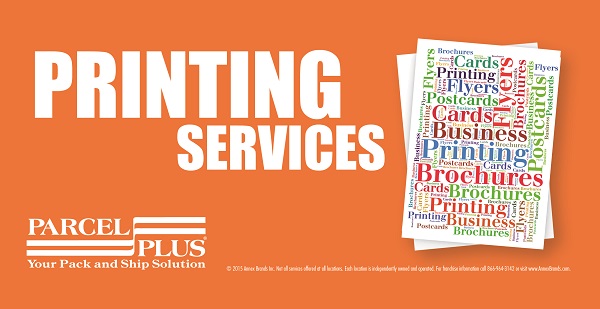Whether it’s a flyer for a child’s soccer tournament, business cards for a new business venture, or invitations for a special event, at some point, most people will find themselves in need of printing services. However, the world of printing has its own language that can become confusing to those not directly involved in the printing and copying industry. To help you understand common printing lingo, the printing professionals at Parcel Plus have created a list of frequently used printing terms.
Printing Terms
Color Printing Terms
- CMYK: An acronym for Cyan, Magenta, Yellow, and Black. When you do full-color, digital printing, this is the standard color model used.
- 4/4: “Four over four.” Four-color (also called full-color) printing on the front side, and four-color printing on the back side.
- 4/0: “Four over zero.” Full-color printing on the front and no printing on the back.
- An easy way to remember the difference between 4/4 and 4/0 printing is to remember that the first number is the number of colors on the front, and the second number is the number of colors on the back.
Methods of Printing
- Offset Printing: A traditional printing method where a machine applies individual layers of ink, one at a time, similar to the way a printing press works. The buildup of the different colors creates images and text on the page.
- Digital Printing: A modern printing method where the ink is applied in one pass, all at the same time, to create the images and text on the page.
- Full Bleed: With this technique, the printing goes past (bleeds off) the edge of the sheet, allowing the finished product to have no unprinted edges after the piece is trimmed. Conversely, no bleed printing is what your desktop printer at home does – it leaves a white margin around the edges of the paper.
Weights of Paper
- Text Weight: 20-24lb. This is thin, flexible paper, similar to standard office paper.
- 80lb text – this paper is a little heavier than typical office paper and is best for double-sided printing since there will be minimal show-through. 80lb text is frequently used for flyers and brochures.
- 100lb text – this paper feels similar to standard copy paper, but is heavier. 100lb text is an alternative for printing jobs that require thick paper, but not something as thick as cardstock.
- Cover Weight: This is thick, sturdy paper, commonly referred to as cardstock.
- 80lb cover – A thin cardstock, typically used for business cards.
- 100lb cover – A heavy cardstock; this is often used for postcards and invitations
There are many, many options for weights of paper used in printing, but we’ve only listed the most common.Consult your printing professional for more information about the right paper weights for your specific project.
Paper Thickness
- 14pt.: “pt” refers to the thickness of the paper. A 14pt thickness is about 0.39mm thick.
- 16pt: is thicker paper; it’s about 0.41mm thick
Finishing Terms
Once your project is printed, the way you choose to have it finished can impact the overall appearance of the completed product.
Binding
- Spiral – A binding technique where a wire is wound through holes punched into one side of the paper; also referred to as “coil binding.” This type of binding is commonly used for reports and manuals.
- Perfect – A binding method where one edge of a group of pages is held together by a flexible adhesive. This is typically used for paperback books, catalogs, and magazines.
- Comb – A binding option where holes are punched into one edge of a group of papers, and the teeth of a flexible, plastic comb are inserted into the holes to hold the stack together. This method is often used for catalogs, reports and manuals.
Coating
- Aqueous - A clear, non-toxic coating that is applied like ink. This is a fast-drying, water-based coating that is used to protect the paper and add a glossy appearance to the printed piece.
- UV - A very shiny and durable high gloss coating that is applied to printed material as a liquid, then cured with ultraviolet light. This coating is very durable and is best for printed material that needs extra protection.
- C2S and C1S – C1S is short for “Coated One Side”; C2S is short for “Coated Two Sides.”
- For Example: 14pt C2S is commonly used for business cards. So, “14pt” is the thickness of the paper, and “C2S” indicates the paper is coated on both sides.
Now, the next time you need something printed, you can accurately communicate to your printing professional the type of service you need. Just visit the Parcel Plus location nearest you, and the friendly staff will help you select the right printing option and quickly complete your project. Whether you need invitations for a special event, flyers for a real estate listing, business cards, or postcards to promote your business, the professionals at Parcel Plus will help you with every step of the printing process.

